danbricklin.com/log
|
||
|
|
Starting February 1, 2002
Gerda Lakritz, More cell tower pictures, Visit to CIMIT, Enron and Readable Source, Happy Birthday Mom!, Usability results from UIE
01-07Feb02
2002_02_01.htm
|
|
Thursday, February 7, 2002
Gerda Lakritz
My aunt Gerda Lakritz, my mother's only sibling, died this past week after a long illness. She was a strong woman who knew how to express herself very well. She brought up two of my cousins, really great people, and was a wonderful wife to her late husband who died 11 years ago. She also was very supportive of me and my siblings. As a child, she always told me how she knew I'd win a Nobel Prize and she'd be there in the front row throwing me a kiss. While a Nobel Prize is highly unlikely, every time I get some major award I think of her saying that. May she rest in peace.
More cell tower pictures
One of my all-time most popular pages on this web site is the one showing cellular transmission towers disguised as trees. In a companion page, I show more pictures and link to a couple of manufacturers. I just got an email from one of those manufacturers pointing me to a web site they have devoted just to the subject (and their solutions). The company, The Larson Company, also constructs themed environments for theme parks, resorts, etc. Cell towers are just one part of their work. To see the cell tower specific web site, look at "Larson Utility Camouflage", especially the "sites" gallery of pictures.
Visit to CIMIT
Last Thursday I visited the Center for Integration of Medicine and Innovative Technology. Better known as CIMIT, it's members include two major Harvard teaching hospitals, Massachusetts General (MGH) and the Brigham and Women's (BWH), as well as the Massachusetts Institute of Technology (MIT) and the Charles Stark Draper Laboratory. It resides within the Partners HealthCare System. Their mission: "To improve patient care by bringing together scientists, engineers and clinicians to catalyze development of innovative technology, emphasizing minimally invasive diagnosis and therapy."
They had some of the researchers present their work to those of us attending, then gave us a short tour of some of the work in that building. I assume the meeting was part of their outreach and fund raising. (While many of the technologies they bring together are funded by government and private sources with lots of money, the coordination CIMIT does must be separately funded. Original funding came from DoD, since patient care is important both in respect to veterans and armed forces.) I find interdisciplinary projects like the ones they do so inspiring. We really do need to connect diverse technologies and needs.
 Listening to the presentations
One of the presentations was about how they are trying to find ways to detect and treat vulnerable plaque (those deposits in your body that can block your bloodstream). You normally build up a variety of plaques, but if they can determine which ones are most vulnerable to causing problems, and attack them, then lots of lives can be saved. They sort of know how to detect them in dead patients after the fact, the goal is to do it in living people. They're trying combinations of MRI, ultrasound, nuclear imaging, OCT, and lots of other techniques, together with different therapies and statistical analysis.
Another project was "Microsystems for Medicine". They are using micro- and nano- electromechanical systems (MEMS and NEMS) for sensor technology and microfabrication for tissue-engineered organs. They're building devices that are on the same scale of size as cells. For example, certain chemicals have been identified as bio-markers for various diseases (e.g., acetone for diabetes, ammonium for kidney failure). They're developing the microCanary (µCanary) blood assay sensor. They build a sensor out of tiny combs that nearly touch on one side of a substrate using chip-making equipment. Then they put various receptor coatings on the other side. There is a mass change due to absorption of what they are looking for by the coating which causes a resonant frequency shift of the comb assembly. They can build many of these sensors on an inexpensive chip and check for lots of different things at once.
We also heard a presentation from the "Wireless Sensors/Actuator Network" project. This is part of the "operating room of the future" project. They are building a "patient-centric network", using technologies like sensor to Bluetooth to 802.11 to LAN. They see that traditional medicine uses many special purpose devices, each with its own sensors, logic, and readouts, like this:
 Traditional cardiac monitoring device
Instead, they are looking to a different architecture. They take all the sensors, and digitize their output. The raw data is then made available on a LAN (either realtime or from disk storage) to computers with programs to do something with it. They can do sophisticated analysis, like this example of separating the sounds of the heart and lung from a piezoelectric stethoscope:
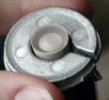 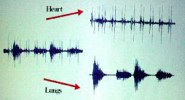 "Stethoscope" sensor, raw signal and processed version showing separate heart and lung sounds
They also showed a "synthetic" heart monitor that showed a heartbeat derived from multiple sources (e.g., EKG, stethoscope, blood pressure cuff, etc.) and then kept providing reliable information even when one source was noisy or disconnected. Readings from a patient walking around a hospital could be made available to doctors anywhere.
After the presentations, we got to try our hands at doing a medical intervention in their emergency room simulator. Analogous to an aircraft simulator, the person running the simulation can make a very realistic simulated patient (I could feel the pulse and hear the breathing with a regular stethoscope!) have all sorts of complications. Here are some pictures:
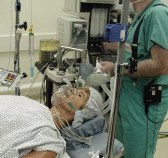 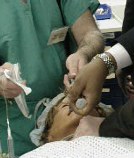 We had to put a tube down to "her" lungs
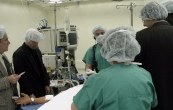 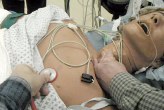 We also had to check her breathing in both lungs (one wasn't filling) and block something in her throat
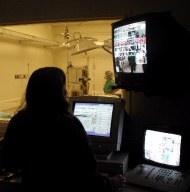 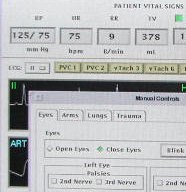 The person behind the one-way mirror and her controls
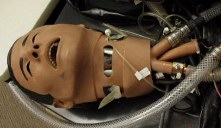 Extra parts we passed on the way out
This set up is really used to train anesthesiologists. We got to see a video of what it looks like when an inexperienced team tries to deal with a common complication. It makes you happy to know they can now learn on simulators...
Enron and Readable Source
I posted some thoughts about Enron on the SATN.org web site.
Friday, February 1, 2002
Happy Birthday Mom!
Today is my mother Ruth's 75th birthday. Happy Birthday, Mom! (She reads this web log...)
 A recent picture of my mother
Usability results from UIE
If you are interested in web site design, eCommerce, or just normal usability issues, Jared Spool's User Interface Engineering publishes some interesting results that are worth reading. Their latest one goes through the "sieve" of losing people who are intending to purchase something from a web site as they go from page to page. Most interesting to me was how important the product descriptions are. You need to have a very wide range of information or else you'll lose somebody and those somebodies add up. You can read "The Customer Sieve". The results are applicable to more than just sites that sell. Also, you can sign up to receive their tips by email (they're not that frequent to be a bother).
|
||
|
© Copyright 1999-2018 by Daniel Bricklin
All Rights Reserved.
|
||

